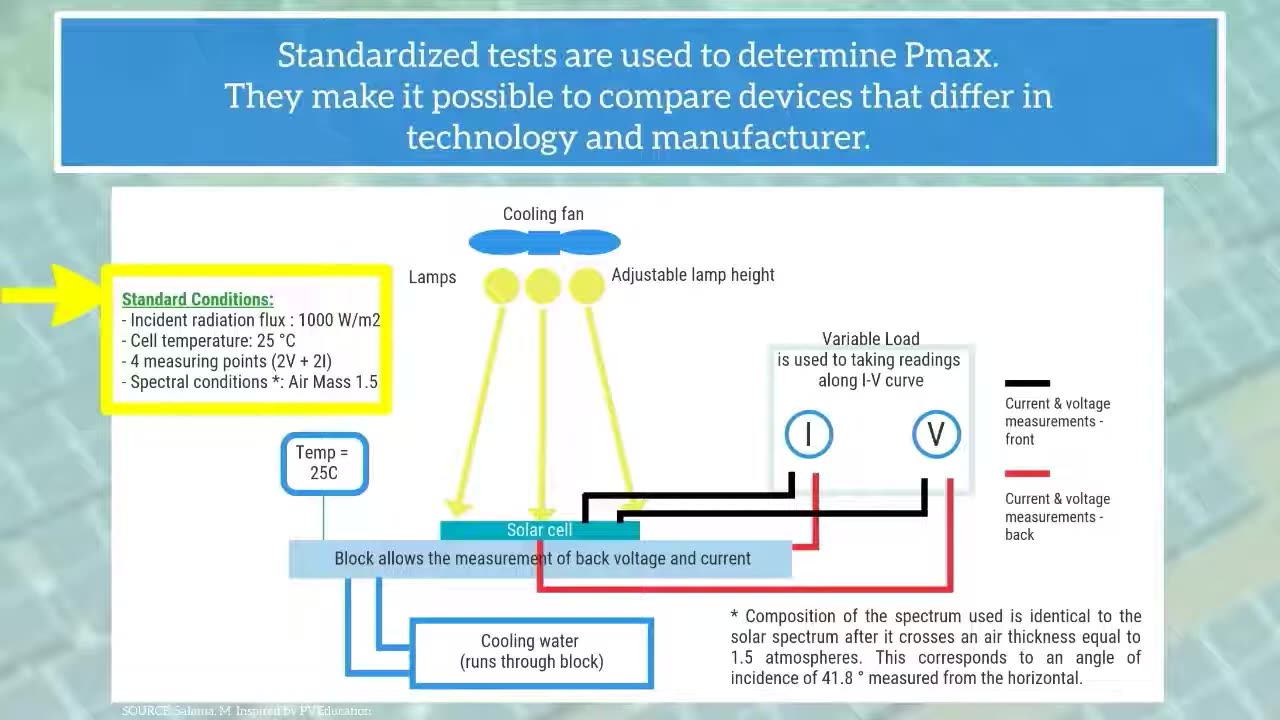Premium Only Content

How is the efficiency of a solar cell measured?
Researchers are continually striving to improve the efficiency of solar cells. But what exactly does the term "efficiency" mean in the solar industry? How is it measured?
This video is part of iPolytek's online course on solar energy. iPolytek, Professional Development Courses for Engineers.
The efficiency of a solar cell is equal to the ratio between the electrical power it produces and the power it receives from the sun.
To measure the efficiency of a solar cell or solar module, the standard value of E = 1000 W / m2 is used.
According to this definition, the smaller the area needed to produce Pmax, the higher the efficiency.
So, how is Pmax measured? By constructing the IV curve (or the current versus voltage curve) of the solar cell.
The current that is measured when there is no voltage is called the short-circuit current, Isc. At this point, power equals 0.
The voltage that is observed when no current is flowing is called the open-circuit voltage, Voc. At this point, power also equals 0.
Since, Power = I x V :
The P-V curve is obtained by multiplying, point by point, all the voltages and currents between the short circuit and open circuit conditions.
Then we can simply read Pmax since it is the peak of the P-V curve. Once we know Pmax, we can read Vmp (the voltage at maximum power) from the P-V curve.
Next, we use the I-V curve to determine Imp (current at max power) from Vmp.
-
 LIVE
LIVE
BlackDiamondGunsandGear
1 hour agoAre ALL Striker Fired Pistols UNSAFE? // After Hours Armory
453 watching -
 LIVE
LIVE
SpartakusLIVE
5 hours ago#1 Saturday Spartoons on RUMBLE PREMIUM
5,913 watching -
 DVR
DVR
Man in America
6 hours ago“Summoning the Demon” — The AI Agenda Is FAR WORSE Than We Know w/ Kay Rubacek
8.02K6 -
 LIVE
LIVE
Tundra Tactical
4 hours ago🎯💥 The World’s Okayest Gun Show 🔫😂 | LIVE Tonight on Rumble!
197 watching -
 3:36:03
3:36:03
Mally_Mouse
23 hours ago🌶️ 🥵Spicy BITE Saturday!! 🥵🌶️- Let's Play: Tower Unite!
22.5K1 -
 58:59
58:59
MattMorseTV
4 hours ago $0.76 earned🔴Trump just BROKE Newsom.🔴
42.3K40 -
 18:14
18:14
Her Patriot Voice
4 hours agoWho Is WORSE for NYC: Trump Girl or Socialist?
15.7K23 -
 DVR
DVR
SavageJayGatsby
4 hours agoSpicy Saturday with Mally! | Road to 100 | $300 Weekly Goal for Spicy Bites!
24.6K -
 LIVE
LIVE
FomoTV
6 hours ago🚨 Swamp Theater: FBI Raids Bolton 🕵 Still NO Epstein Files, Trump's Troops & the Red Heifer Hoax 🐂 | Fomocast 08.23.25
88 watching -
 6:04:40
6:04:40
Akademiks
9 hours agoRoc Nation & Meg Thee Stallion did a 7 HOUR Deposition with me. Drake Secret Kid Finally Revealed.
45.1K1